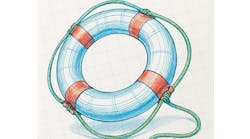Some process control systems are so capable and efficient that they can become a little bit invisible, especially with the passage of time. However, after almost 20 years of service, even the most reliable controls need to be reexamined and likely upgraded.
For instance, biopharmaceutical company AbbVie split from Abbott Laboratories just four years ago, but the last controls upgrade at its facility North Chicago, Ill., was in 1999, after an early D/3 control system from NovaTech was originally installed in 1984. This long lag was largely due to the fact that, while AbbVie is the $26 billion manufacturer of Humira, it also faces stringent validation requirements that push intervals between upgrades to be much longer than in other applications.
[sidebar id =1]
"We needed to get our old VMS servers and Windows 2000 consoles off our network," said Tom Borkman, Ph.D., principal controls engineer at AbbVie. "This was also a corporate IT-driven initiative with engineering and operations support, and our goal was to gain the benefits of running a modern operating system, which would allow both new and experienced operators and engineers to capitalize on the capabilities of the new system while retaining their familiar interfaces and operating procedures."
AbbVie upgrade of its D/3 control system would take it from Version 9.1 all the way up to Version 15, and upgrade 1,200 I/O points and one process control module (PCM) managing 24 fermenter tanks in its product development division. The I/O upgrade on one PCM represented the first phase of a multi-year initiative to migrate I/O to NovaTech’s 8000 Series I/O platform. Borkman presented "Migrating from D/3 Version 9.1 to 15.0 and 16000 to 8000 I/O" on Sept. 19, the second day of the NovaTech Automation Summit 2017 in Baltimore, Md.
To prepare for its 2016 upgrade, Borkman and his colleagues at AbbVie shipped servers and system databases to NovaTech's facility in Owings Mills, Md., while it delivered its new operating system and PCs, and freed up added IP address space. It also sent complex C and general function programs to NoveTech for conversion. "We conducted the factory acceptance test (FAT) in Owings Mills, which included a day and a half for checking databases and three days to check and fix programs," added Borkman. "Our production area wanted a two-day turnaround, and we were able to do it because we had preconfigured servers, prepared new console PCs onsite, and had all-new system IP addresses."
Borkman reports that AbbVie's upgrade benefited it in three primary areas:
- IT gained a cyber-secure D/3 system that substantially increased communication speed between system components.
- Engineering reduced costs by migrating existing applications; reduced configuration time with a graphical program interface; and benefited from abroad familiarity with its Microsoft Windows operating system.
- Operations gained the ability to display legacy and modern operator screens which enabled a smoother transition; achieved quick turnaround time that minimized the project's impact on production and revenues; and avoided risks due to software and hardware obsolescence.
The upgrade at AbbVie also required its staff to learn new software as they transitioned from SSD to WinSSD and from Mod to WinMod; completed individual build files in D3 Architect; adopted D3 Manager software; and replaced some C programs for creating summary reports.
"We also had some initial problems with operator console logins when PCs dropped off the domains," explained Borkman. "Servers needed to be added to the domain, and corrections needed to be added to D/3 for checking domain groups.
To upgrade its I/O system, AbbVie identified one redundant PCM, its 16000 I/O and a few Quantum Modicon I/O for migration. "We also found a lot of legacy boards and setups, and I/O boards that were not in the proper slots. We removed many I/O cards and replaced them with bridge cards," added Borkman. "As a result, for the PCM database conversion, all layout work and drawings were done in Owings Mills. We documented four-wire versus two-wire inputs; changed to Extreme Networks switches that had extra ports for future upgrades; added fans to the PCM1 style cabinets; and conducted a 100%, point-by-point inspection. We recommend starting with one PCM for testing the new I/O.
In the end, the upgrade exceeded expectations. “Some things don’t always go as planned,” added Borkman. “However, we gained more reliability and better support.”






